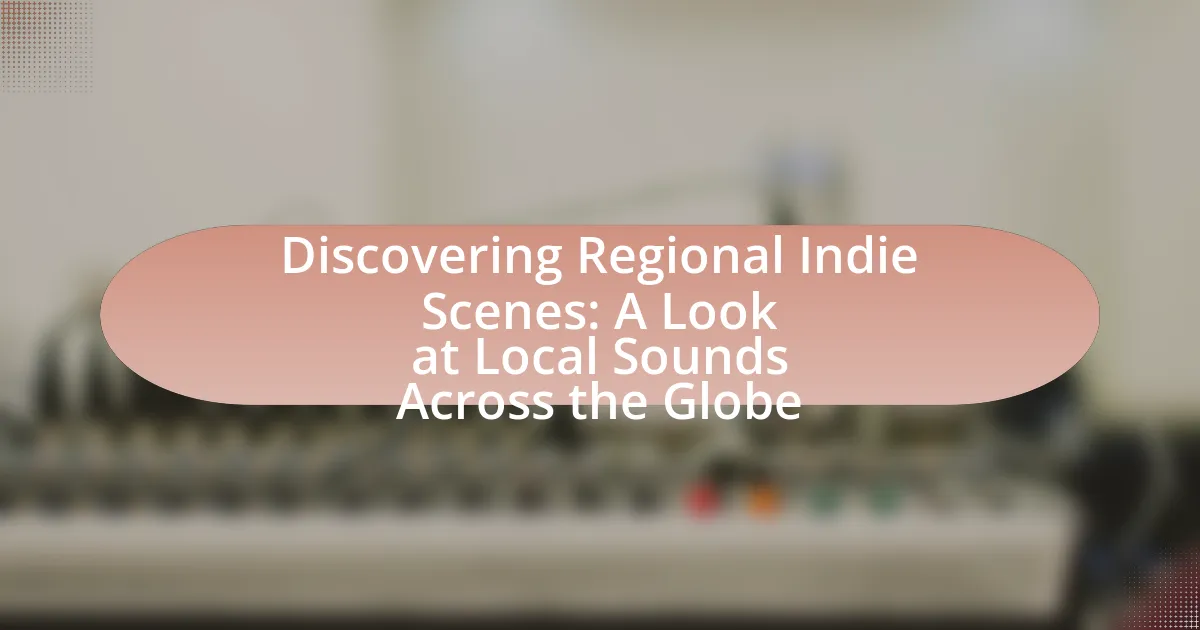Regional indie scenes are localized music communities that nurture independent artists and bands, characterized by distinct sounds and cultural influences tied to their geographic areas. This article explores the differences between regional indie scenes and mainstream music, highlighting the importance of local culture, community engagement, and the unique characteristics that define these scenes. It examines factors contributing to their development, the influence of local demographics, and the role of venues and festivals in shaping the music landscape. Additionally, the article discusses methods for discovering and supporting local indie artists, the impact of economic factors on these scenes, and notable regional indie scenes worldwide, providing a comprehensive overview of the vibrant and diverse world of regional indie music.
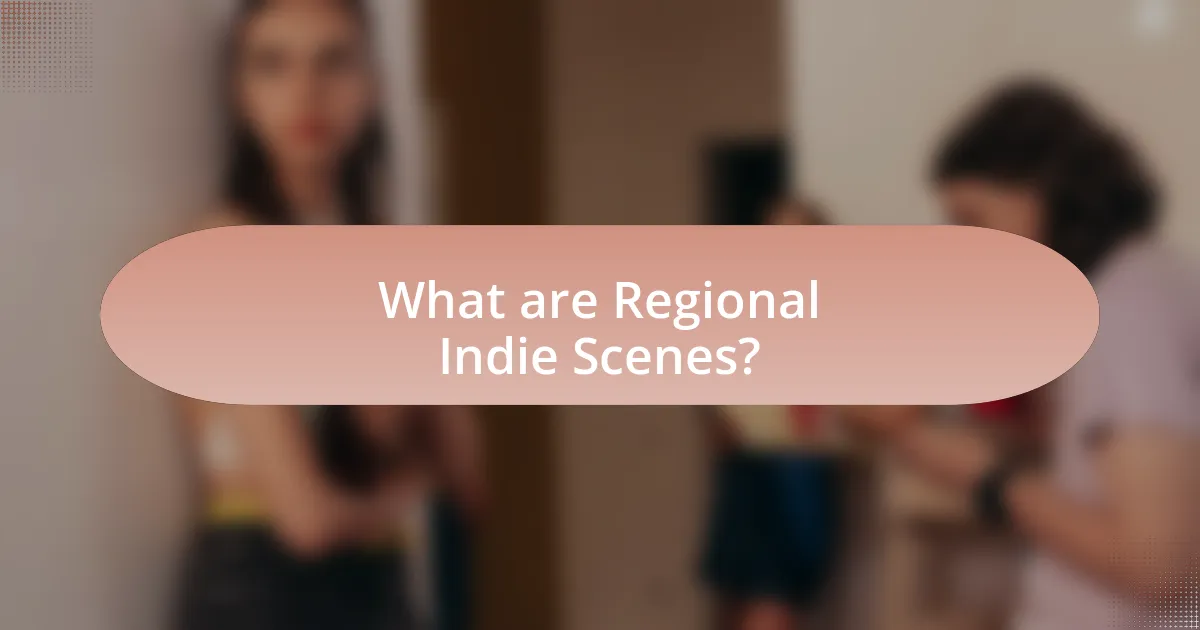
What are Regional Indie Scenes?
Regional indie scenes are localized music communities that foster independent artists and bands, often characterized by unique sounds and cultural influences specific to their geographic areas. These scenes typically emerge in cities or regions where musicians collaborate, perform, and share resources, creating a vibrant ecosystem that supports diverse musical expressions. For example, the Seattle indie scene in the 1990s produced grunge music, while the Austin scene is known for its eclectic mix of genres, showcasing how regional characteristics shape the music produced.
How do Regional Indie Scenes differ from mainstream music?
Regional indie scenes differ from mainstream music primarily in their focus on local culture and community engagement. While mainstream music often prioritizes commercial viability and broad appeal, regional indie scenes emphasize artistic expression, experimentation, and authenticity, reflecting the unique cultural identities of their locales. For example, indie artists frequently draw inspiration from local traditions, languages, and social issues, creating music that resonates deeply with their immediate audiences. This localized approach fosters a sense of belonging and connection among listeners, contrasting with the often generic themes found in mainstream hits. Additionally, regional indie scenes typically operate outside major record label systems, allowing for greater creative freedom and innovation, which can lead to diverse sounds and genres that are less represented in mainstream music.
What characteristics define a Regional Indie Scene?
A Regional Indie Scene is defined by its unique blend of local culture, diverse musical styles, and community-driven initiatives. These scenes often emerge in specific geographic areas, showcasing artists who reflect the social, political, and cultural narratives of their surroundings. For instance, the Seattle indie scene in the 1990s was characterized by its grunge sound, which was influenced by the city’s socio-economic conditions and youth culture. Additionally, regional indie scenes typically prioritize independent venues, local record labels, and grassroots promotion, fostering a sense of collaboration among artists and audiences. This localized focus not only cultivates distinct musical identities but also strengthens community ties, as seen in the vibrant indie scenes of cities like Austin and Portland, where local festivals and events celebrate homegrown talent.
Why are Regional Indie Scenes important for local cultures?
Regional indie scenes are important for local cultures because they foster unique artistic expressions that reflect the community’s identity and values. These scenes provide a platform for local musicians and artists to showcase their work, often drawing inspiration from regional history, traditions, and social issues. For instance, the rise of indie music in cities like Seattle during the 1990s not only highlighted local talent but also influenced the cultural landscape, contributing to the city’s identity as a hub for innovation and creativity. Additionally, regional indie scenes encourage community engagement and collaboration, as local artists often work together and support one another, strengthening social ties and cultural cohesion.
What factors contribute to the development of Regional Indie Scenes?
Regional indie scenes develop due to a combination of local culture, community support, access to resources, and the influence of technology. Local culture shapes the unique sound and identity of the indie scene, as artists draw inspiration from their surroundings and experiences. Community support, including local venues, festivals, and music collectives, fosters collaboration and provides platforms for emerging artists. Access to resources such as recording studios and funding opportunities enables musicians to produce and promote their work. Additionally, technology, particularly social media and streaming platforms, allows artists to reach wider audiences and connect with fans, further enhancing the growth of regional indie scenes.
How do local demographics influence music styles?
Local demographics significantly influence music styles by shaping the cultural, social, and economic contexts in which music is created and consumed. For instance, areas with diverse populations often produce hybrid music styles that blend various cultural influences, such as the fusion of Latin rhythms with hip-hop in urban centers like Los Angeles. Additionally, socioeconomic factors can dictate the accessibility of musical resources, leading to the prevalence of certain genres; for example, economically disadvantaged neighborhoods may foster genres like blues or punk that express social struggles. Research indicates that demographic factors such as age, ethnicity, and education level directly correlate with musical preferences and production, as seen in studies like “The Role of Demographics in Music Preferences” by North and Hargreaves, which highlights how different demographic groups gravitate towards distinct musical styles based on their cultural backgrounds and life experiences.
What role do local venues and festivals play in shaping these scenes?
Local venues and festivals are crucial in shaping regional indie music scenes by providing platforms for artists to perform and connect with audiences. These spaces foster community engagement, allowing local musicians to showcase their work, gain exposure, and build a following. For instance, festivals like South by Southwest in Austin, Texas, have historically launched the careers of numerous indie artists, demonstrating the significant impact of such events on the music landscape. Additionally, local venues often curate diverse lineups that reflect the unique cultural identity of their regions, further enriching the indie music ecosystem.
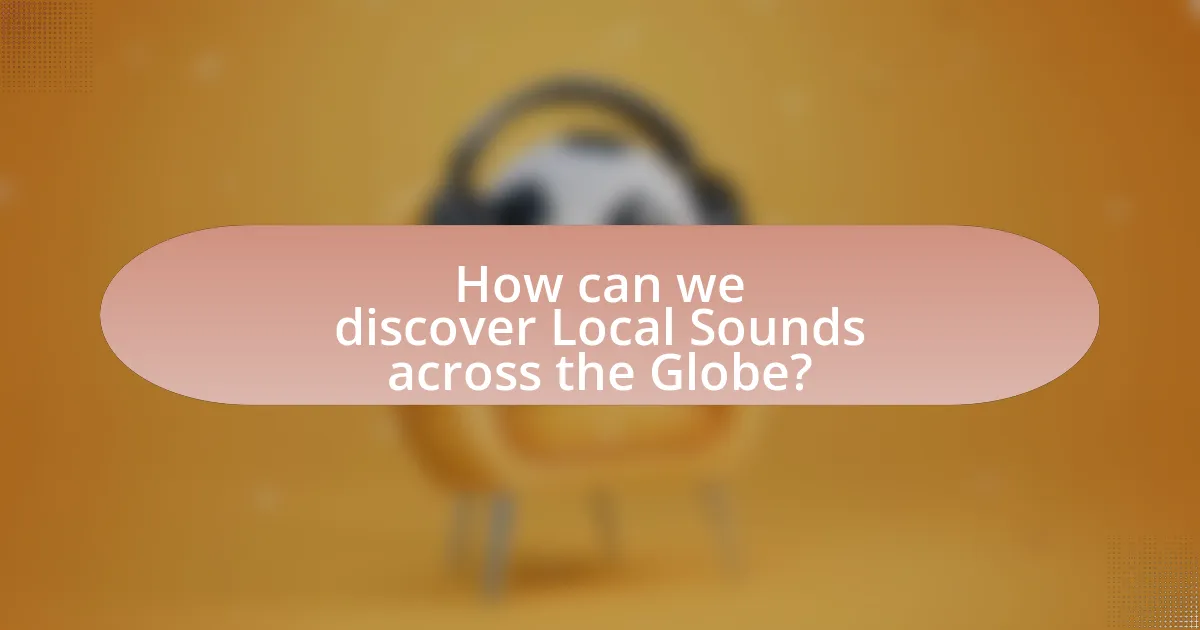
How can we discover Local Sounds across the Globe?
To discover local sounds across the globe, one can utilize digital platforms that curate regional music, such as Bandcamp, SoundCloud, and Spotify, which feature local artists and genres. These platforms often categorize music by location, allowing users to explore sounds specific to different regions. Additionally, attending local music festivals and events provides firsthand exposure to indigenous sounds and emerging artists. Research indicates that local music scenes thrive in urban areas, where diverse cultural influences converge, making cities like Berlin, Tokyo, and Lagos hotspots for discovering unique sounds. Engaging with local communities through social media and music blogs can also enhance the discovery process, as these channels often highlight underground artists and niche genres.
What are effective methods for exploring Regional Indie Scenes?
Effective methods for exploring Regional Indie Scenes include attending local music festivals, engaging with community radio stations, and utilizing social media platforms to discover emerging artists. Attending local music festivals allows for direct exposure to a variety of indie acts, fostering connections with artists and fans alike. Community radio stations often feature local talent and provide insights into the regional music landscape, while social media platforms like Instagram and Bandcamp enable users to follow and support indie musicians, facilitating the discovery of new sounds and trends. These methods are validated by the increasing popularity of local music events and the rise of independent artists gaining recognition through online platforms.
How can social media be utilized to find local indie artists?
Social media can be utilized to find local indie artists by leveraging platforms like Instagram, Facebook, and Twitter to search for location-specific hashtags and artist profiles. These platforms allow users to discover indie artists through geotagged posts, local music events, and community groups dedicated to indie music. For instance, using hashtags such as #IndieArtist followed by a city name can yield posts from local musicians, while joining local music groups on Facebook can provide insights into upcoming shows and artist recommendations. Additionally, platforms like Bandcamp and SoundCloud often feature local artists, and social media can direct users to these platforms for further exploration.
What platforms are best for discovering new regional music?
The best platforms for discovering new regional music include Bandcamp, SoundCloud, and Spotify. Bandcamp allows artists to upload their music directly, often featuring local and indie artists, making it a prime source for regional sounds. SoundCloud offers a vast array of user-uploaded tracks, including many from emerging regional artists, facilitating easy exploration of niche genres. Spotify’s curated playlists, such as “Fresh Finds” and “Global X,” highlight new music from various regions, providing listeners with a diverse selection of local sounds. These platforms collectively support the discovery of regional music through user-generated content and curated playlists, making them essential tools for exploring local indie scenes.
Why is it important to support local indie artists?
Supporting local indie artists is important because it fosters cultural diversity and strengthens community identity. Local indie artists often reflect the unique experiences and stories of their communities, contributing to a rich tapestry of cultural expression. By supporting them, individuals help sustain local economies; for instance, a study by the National Endowment for the Arts found that arts and culture contribute over $877 billion to the U.S. economy, with local artists playing a crucial role in this sector. Additionally, supporting indie artists encourages innovation and creativity, as they often experiment with new sounds and styles that challenge mainstream norms. This not only enriches the local music scene but also provides audiences with fresh and diverse artistic experiences.
What impact does supporting local artists have on the community?
Supporting local artists significantly enhances community cohesion and economic vitality. When communities invest in local artists, they foster a sense of identity and pride, which can lead to increased social interaction and collaboration among residents. Additionally, local artists contribute to the economy by attracting tourism and creating jobs; for instance, a study by the National Endowment for the Arts found that arts-related businesses generate over $877 billion annually in the U.S., supporting millions of jobs. This economic boost, combined with the cultural enrichment provided by local art, creates a vibrant community atmosphere that benefits all residents.
How can listeners contribute to the sustainability of Regional Indie Scenes?
Listeners can contribute to the sustainability of Regional Indie Scenes by actively supporting local artists through attendance at live shows and purchasing their music and merchandise. This direct financial support helps artists cover production costs and sustain their creative endeavors. According to a study by the Music Industry Research Association, local music scenes thrive when community members engage, as it fosters a sense of belonging and encourages artists to continue creating. Additionally, listeners can promote local acts on social media, increasing visibility and attracting new audiences, which further strengthens the scene.
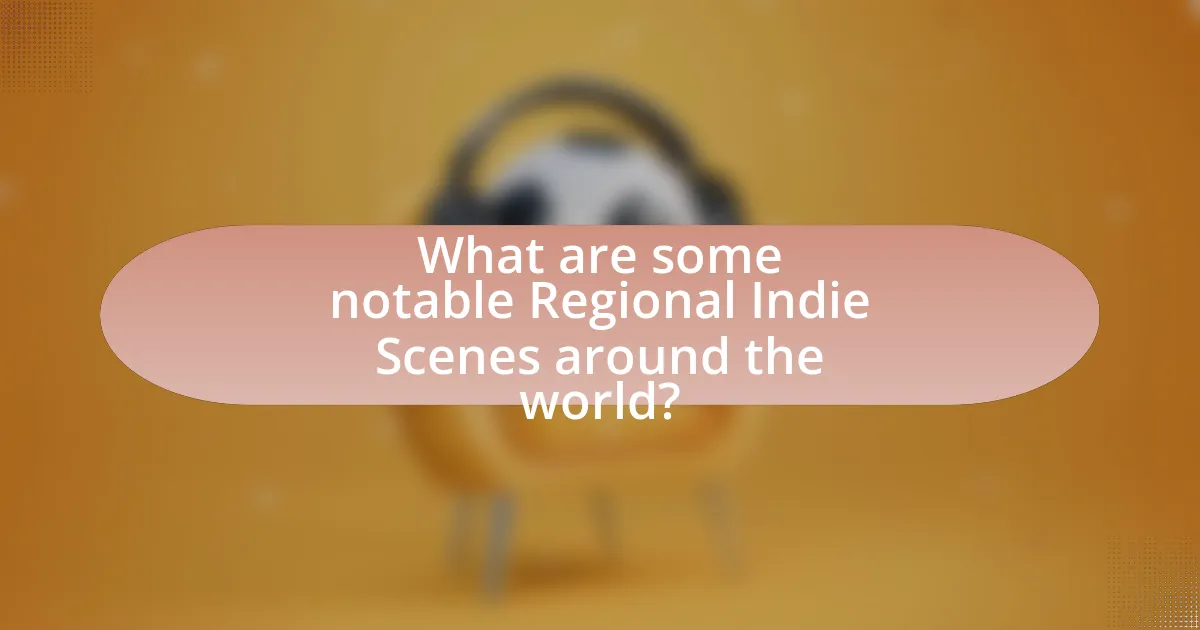
What are some notable Regional Indie Scenes around the world?
Notable regional indie scenes around the world include the following:
- The Pacific Northwest in the United States, particularly Seattle and Portland, is known for its vibrant indie rock scene, producing influential bands like Death Cab for Cutie and Modest Mouse.
- The UK has a strong indie scene, especially in London and Manchester, where bands like Arctic Monkeys and The Smiths emerged, shaping the genre’s landscape.
- In Australia, Melbourne is recognized for its diverse indie music culture, with acts like Tame Impala and Courtney Barnett gaining international acclaim.
- The Canadian city of Montreal has a thriving indie scene, highlighted by the presence of the Montreal International Jazz Festival and artists like Arcade Fire and Godspeed You! Black Emperor.
- In Brazil, São Paulo’s indie scene is notable for its eclectic mix of genres, with bands like Boogarins and Tulipa Ruiz contributing to its unique sound.
These scenes are characterized by their local music festivals, independent record labels, and a community of artists that foster creativity and collaboration.
Which cities are recognized for their vibrant indie music cultures?
Cities recognized for their vibrant indie music cultures include Austin, Texas; Portland, Oregon; and Brooklyn, New York. Austin is known for its annual South by Southwest (SXSW) festival, which showcases numerous indie artists and has earned the city the title “Live Music Capital of the World.” Portland boasts a thriving local scene with venues like the Doug Fir Lounge and a strong emphasis on DIY culture, contributing to its reputation as an indie music hub. Brooklyn has become a focal point for emerging indie bands, with neighborhoods like Williamsburg hosting a variety of music venues and festivals that highlight local talent.
What unique sounds emerge from these cities?
Unique sounds from cities around the globe often reflect their cultural heritage and local influences. For instance, the vibrant street music of New Orleans features jazz and blues, rooted in African American history, while the indie scene in Berlin showcases electronic music, influenced by the city’s post-reunification artistic revival. In contrast, the folk sounds of Nashville are characterized by country music, which has deep ties to Southern traditions. Each city’s unique soundscape is shaped by its history, demographics, and artistic movements, making them distinct and representative of their local culture.
How do cultural influences shape the music in these regions?
Cultural influences shape the music in these regions by integrating local traditions, languages, and social practices into musical forms. For instance, in regions with strong indigenous roots, traditional instruments and folk melodies often blend with contemporary styles, creating unique sounds that reflect cultural heritage. Additionally, globalization introduces diverse musical genres, prompting local artists to incorporate elements from various cultures, which can be seen in the fusion of hip-hop with traditional rhythms in urban areas. This interplay of local and global influences not only enriches the music but also serves as a medium for cultural expression and identity, as evidenced by the rise of genres like Afrobeat, which combines African musical elements with jazz and funk, showcasing the dynamic relationship between culture and music.
What challenges do Regional Indie Scenes face?
Regional indie scenes face significant challenges, including limited funding, lack of exposure, and competition from mainstream music. These factors hinder the growth and sustainability of local artists and venues. For instance, a study by the Music Industry Research Association found that 70% of indie musicians struggle to secure financial backing, which restricts their ability to produce and promote their work. Additionally, regional scenes often lack access to major media outlets, resulting in minimal visibility compared to mainstream acts. This disparity is compounded by the dominance of major labels, which can overshadow local talent and create barriers to entry for emerging artists.
How do economic factors affect local music scenes?
Economic factors significantly influence local music scenes by determining the availability of funding, venues, and audience engagement. For instance, a thriving local economy can lead to increased disposable income, allowing residents to spend more on live music events and merchandise. Conversely, economic downturns often result in reduced funding for arts programs and fewer opportunities for musicians to perform, as venues may close or reduce their programming. According to a study by the National Endowment for the Arts, communities with higher economic investment in the arts see a 4.5% increase in local music events, demonstrating a direct correlation between economic health and the vibrancy of music scenes.
What are the barriers to entry for new indie artists?
New indie artists face several barriers to entry, including limited access to funding, lack of industry connections, and challenges in marketing and distribution. Funding is often scarce, as many new artists rely on personal savings or small grants, making it difficult to produce quality recordings or promote their work effectively. Additionally, without established networks within the music industry, new artists struggle to secure gigs, collaborations, or mentorship opportunities that can help them grow. Marketing and distribution pose further challenges, as the digital landscape is saturated, making it hard for new artists to stand out and reach their target audience. According to a 2021 report by the Music Industry Research Association, 70% of indie artists cite financial constraints as a significant barrier to their success.
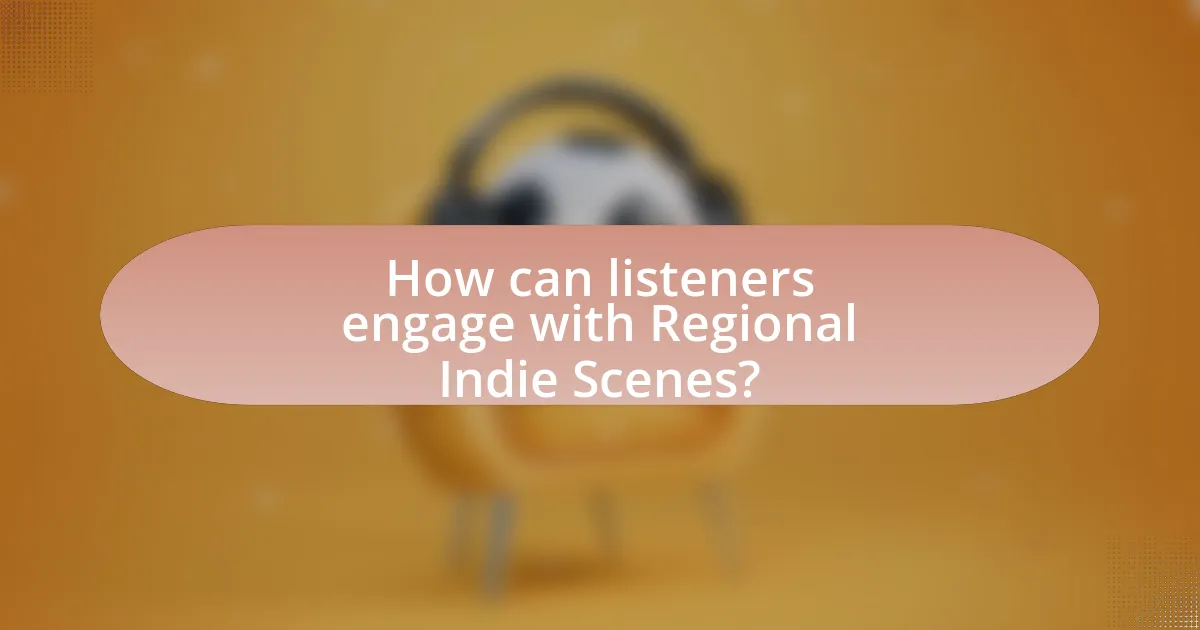
How can listeners engage with Regional Indie Scenes?
Listeners can engage with Regional Indie Scenes by attending local concerts and music festivals that showcase regional artists. This direct participation allows listeners to experience the music in its cultural context and support local musicians financially. According to a 2022 report by the National Independent Venue Association, local music events contribute significantly to community engagement and economic growth, with 75% of attendees stating they are more likely to support local businesses after attending a live music event. Additionally, listeners can follow regional indie artists on social media platforms, stream their music on digital platforms, and participate in local music forums to foster a deeper connection with the scene.
What are some best practices for supporting local indie music?
To support local indie music, individuals and communities should prioritize attending live shows, purchasing music directly from artists, and promoting local acts through social media. Attending live performances not only provides financial support to musicians but also fosters a vibrant local music scene, as evidenced by studies showing that live music events can significantly boost local economies. Purchasing music directly from artists, whether through Bandcamp or at shows, ensures that a larger portion of the revenue goes to the musicians, which is crucial for their sustainability. Promoting local acts on social media amplifies their reach and helps build a dedicated fan base, as platforms like Instagram and Facebook have proven effective for grassroots marketing in the music industry.
How can attending live shows benefit both artists and audiences?
Attending live shows benefits both artists and audiences by fostering direct engagement and creating a shared experience. For artists, live performances provide an opportunity to showcase their talent, build a fan base, and generate revenue through ticket sales and merchandise. According to a report by the National Independent Venue Association, live music events contribute significantly to local economies, with venues generating over $10 billion annually in ticket sales alone. For audiences, attending live shows enhances their connection to the music and the artist, offering an immersive experience that recorded music cannot replicate. This interaction often leads to a stronger emotional bond and loyalty to the artist, as evidenced by studies showing that fans who attend live performances are more likely to purchase music and merchandise.
What role does merchandise play in supporting indie artists?
Merchandise plays a crucial role in supporting indie artists by providing an additional revenue stream that is often essential for their financial sustainability. Indie artists typically face challenges in securing funding and exposure, making merchandise sales vital for covering production costs, touring expenses, and marketing efforts. For instance, a study by the Music Industry Research Association found that merchandise sales can account for up to 30% of an indie artist’s income, highlighting its significance in their overall financial ecosystem. Additionally, merchandise serves as a marketing tool, helping to promote the artist’s brand and music while fostering a deeper connection with fans.
What resources are available for discovering and supporting local sounds?
Local sounds can be discovered and supported through various resources such as community radio stations, local music festivals, and online platforms like Bandcamp and SoundCloud. Community radio stations often feature local artists and provide a platform for their music, while local music festivals showcase regional talent and foster connections within the music community. Online platforms like Bandcamp allow users to discover and purchase music directly from local artists, supporting them financially. Additionally, social media groups and local music blogs can serve as valuable resources for finding and promoting local sounds, creating a network for artists and fans alike.
How can music blogs and podcasts enhance the discovery process?
Music blogs and podcasts enhance the discovery process by providing curated content that highlights emerging artists and local sounds. These platforms often feature in-depth interviews, reviews, and playlists that introduce listeners to new music that may not be accessible through mainstream channels. For instance, a study by the Pew Research Center found that 54% of podcast listeners discover new music through podcasts, indicating their effectiveness in promoting lesser-known artists. Additionally, music blogs often focus on specific genres or regional scenes, allowing users to explore niche markets and discover unique sounds that reflect local cultures.
What community initiatives exist to promote local indie music?
Community initiatives that promote local indie music include local music festivals, artist collectives, and community radio stations. These initiatives provide platforms for indie musicians to perform, collaborate, and gain exposure. For example, events like the South by Southwest (SXSW) festival in Austin, Texas, showcase emerging indie artists, while collectives such as the DIY Musician Collective offer resources and networking opportunities. Additionally, community radio stations often feature local indie music in their programming, helping to reach wider audiences and support local talent. These initiatives are crucial for fostering a vibrant indie music scene and connecting artists with their communities.
What are practical tips for exploring Regional Indie Scenes?
To explore regional indie scenes effectively, attend local music festivals and showcases that feature emerging artists. Engaging with these events allows you to discover unique sounds and connect with local musicians. Additionally, follow local music blogs and social media accounts dedicated to indie music, as they often highlight new releases and upcoming shows. Visiting local record stores can also provide insights into the regional music landscape, as staff recommendations often reflect the community’s favorites. Networking with local music enthusiasts and artists can further enhance your understanding of the scene, as personal recommendations often lead to hidden gems.
